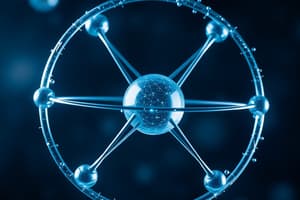Podcast
Questions and Answers
What is a scientific theory?
What is a scientific theory?
A scientific theory is a set of scientific facts linked together to explain an observation.
What is the particle model?
What is the particle model?
The particle model is a scientific theory that states that all matter is made of particles.
What are the different states of matter?
What are the different states of matter?
The different states of matter are solids, liquids, and gases.
What are particles attracted by?
What are particles attracted by?
What happens to particles when they are heated?
What happens to particles when they are heated?
What is the role of scientific facts in a scientific theory?
What is the role of scientific facts in a scientific theory?
How does the particle model explain the properties of different states of matter?
How does the particle model explain the properties of different states of matter?
What are some examples of different particles that make up different materials?
What are some examples of different particles that make up different materials?
What happens to particles when they are heated?
What happens to particles when they are heated?
How do attractive forces between particles change with their proximity?
How do attractive forces between particles change with their proximity?
Study Notes
Scientific Theory
- A scientific theory is a well-substantiated explanation of an aspect of the natural world based on a body of evidence and scientific reasoning.
- It integrates and explains various scientific facts and is subject to continual testing and revision.
Particle Model
- The particle model describes matter as being composed of small particles that are in constant motion.
- This model provides insight into the behavior and properties of solids, liquids, and gases.
States of Matter
- Matter exists mainly in four states: solid, liquid, gas, and plasma.
- Solids have a fixed shape and volume, liquids have a definite volume but take the shape of their container, and gases neither have a fixed shape nor a fixed volume.
Particles and Attraction
- Particles are attracted to each other by intermolecular forces which can vary in strength depending on the type of matter.
- These forces are responsible for determining the state of matter; stronger forces result in solids, whereas weaker forces can lead to gases.
Effect of Heating on Particles
- Heating increases the kinetic energy of particles, causing them to move faster.
- As energy is added, particles in solids may overcome their fixed positions, leading to a change in state (melting to liquid).
Role of Scientific Facts in Theories
- Scientific facts serve as the foundational evidence that supports scientific theories.
- Theories are refined over time based on new facts, strengthening or modifying the existing framework of understanding.
Particle Model and Properties of Matter
- The particle model explains properties like viscosity, density, and thermal expansion based on the movement and arrangement of particles in different states of matter.
- For example, gases have much greater distances between particles compared to solids, explaining their compressibility.
Examples of Different Particles
- Different materials are made up of various types of particles, such as atoms (e.g., carbon, oxygen) and molecules (e.g., water, glucose).
- Each type of particle has unique properties that contribute to the overall characteristics of the material.
Proximity and Attractive Forces
- Attractive forces between particles increase as they are brought closer together, leading to potential changes in state.
- When particles are far apart, such as in gases, these forces are weak, but they become significantly stronger in solids and liquids.
Studying That Suits You
Use AI to generate personalized quizzes and flashcards to suit your learning preferences.
Description
Test your knowledge of the particle model and states of matter with this quiz! Explore the scientific theory behind the composition of matter and how it relates to the properties of solids, liquids, and gases. Challenge yourself to understand the concept of state changes and the evidence supporting this scientific theory.




